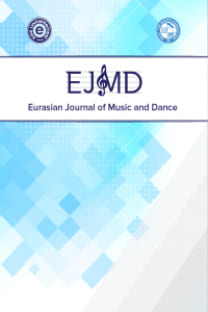KÜLTÜREL MELEZLİK BAĞLAMINDA TEPECİK FİLARMONİ ORKESTRASI
TEPECİK PHİLHARMONİC ORCHESTRA İN THE CONTEXT OF CULTURAL HYBRİDİTY
Turkey is a culturally diverse nation comprised of many ethnicities, each influencingthe artistic and cultural landscape of the country with its distinctive style. Amongthe these ethnicities Roma are the most talented group in terms of adaptation. Themost important reason is the necessity to interact with others as a occupational.Interaction requires the skill of adaptation, so as a result of this process thehybridization can be emerged.In the context of this article, the term hybridization refers to describe processes ofintercultural contact, mixing and combination in the moment of cultural exchange.When there are contacts between communities, -especially musical ones- theinfluences flow in both directions and the result are mostly creative hybrid culturalpractices. The process of globalization is contributing to hybridization today, mostvisibly in the world music performances, from Turkey to India, by conventionalwestern musical instruments and music industry. As an example of Multiplehybridization practices of Tepecik Filarmoni Orkestrası (Tepecik PhilharmonicOrchestra) is remarkable
Keywords:
Appropriation, Roma of Izmir Tepecik Cultural Hybridity,
___
- ASHCROFT, Bill. GRIFFITHS, Gareth. TIFFIN, Helen. (2007). Post-Colonial Studies The Key Concepts, New York: Routledge.
- BARTH, Fredrik (2001). “Giriş”, Etnik Gruplar ve Sınırları Kültürel Farklılığın Toplumsal Organizasyonu, (Çev: Ayhan Kaya - Seda Gürkan), İstanbul: Bağlam Yayınları.
- BAILY, John. COLLYER, Michael. (2006). “Introduction: Music and Migration”, Journal of Ethnic and Migration Studie, Vol. 32. No.2, ss.167-182, New York: Routledge.
- BERGER, Hermann (2006). Çingene Mitolojisi, (Çev. Musa Yaşar Sağlam), Ankara: Ayraç Yayıncılık.
- BURKE, Peter (2011). Kültürel Melezlik, (Çev. Mustafa Topal), İstanbul: Asur Yayınları.
- CALHOUN, Craig (1998). “Community without Propinquity Revisited: Communications Technology and the Transformation of the Urban Public Sphere”, Sociological Inquiry, Vol. 68, No. 3, s. 391, Texas: University of Texas Press.
- COHEN, Anthony P. (1999). Topluluğun Simgesel Kuruluşu, (Çev: Mehmet Küçük), İstanbul: Dost Kitabevi Yayınları.
- DUYGULU, Melih (2006). Türkiye’de Çingene Müziği Batı Grubu Romanlarında Müzik Kültürü, İstanbul: Pan Yayıncılık. GAZİMİHAL, Mahmut Ragıp (1998). “Çingene Çalgıcılar”, Müzikalite Mevsimlik Müzik Haber Dergisi, Sayı: 6, ss. 46-47, Ankara.
- MUTLU, Kubilay (2009). Hemşin Kültürel Kimliğinin Müziksel Dinamikleri, İzmir: D.E.Ü. Güzel Sanatlar Ens., Yayınlanmamış Yüksek Lisans Tezi.
- ONG, Walter J. (1995). Sözlü ve Yazılı Kültür Sözün Teknolojileşmesi, (Çev: Sema Postacıoğlu Banon), İstanbul: Metis Yayınları.
- YÜKSELSİN, İbrahim Yavuz (2000). Batı Türkiye Romanlarında Kültürel Kimlik, Profesyonel Müzisyenlik ve Müziksel Yaratıcılık, İzmir: D.E.Ü. Sosyal Bilimler Enstitüsü, Yayınlamamış Doktora Tezi.
- ISSN: 2651-4818
- Yayın Aralığı: Yılda 2 Sayı
- Başlangıç: 2011
- Yayıncı: Ege Üniversitesi
Sayıdaki Diğer Makaleler
BİLGİSAYAR MÜZİĞİ DİLLERİNİN TARİHÇESİ
“İZMİR II. ULUSAL MÜZİK SEMPOZYUMU”ARDINDAN ‘MÜZİKTE GELENEK, MODERNİTE VE POSTMODERNİTE’
MANAS DESTANI’NDA ASKERÎ MÜZİK
KÜLTÜREL MELEZLİK BAĞLAMINDA TEPECİK FİLARMONİ ORKESTRASI
17. YÜZYIL MÜZİĞİ’NDE GROUNDBASS TEKNİĞİNİN BAROK DÖNEMİN BAĞLAMINDA TEMSİL ETTİĞİ KİMLİK1
